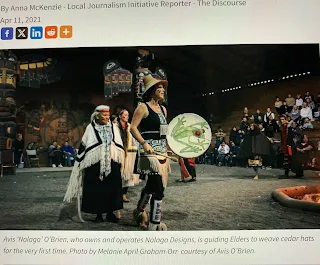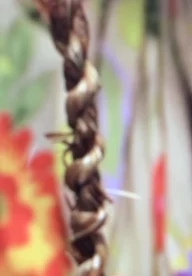Reading
As I reflect on Avis O’Brien’s captivating journey, a Haida
and Kwakwa̱ka̱ʼwakw woman weaving her way back to her cultural roots through
cedar, I am struck by two significant stops in her transformative narrative.
First Stop: Reconnecting through Cedar Medicine
The initial turning point for O’Brien was in 2010 when she
embraced the art of cedar weaving under the guidance of her sister, Meghann
O’Brien. Before this, O’Brien harbored a sense of disconnection and shame about
her identity, a product of historical impacts on Indigenous cultures. The power
of cedar, described as sacred medicine, became the key that unlocked the door
to her cultural heritage. This moment stands out as a powerful testament to the
healing potential embedded within indigenous practices. O’Brien's experience
underscores the idea that cultural reclamation can be a profound path to
self-discovery and reconnection.
Second Stop: Weaving as Cultural Resilience
The historical context woven into O’Brien’s narrative
reveals the deliberate suppression of Indigenous cultural practices by the
Canadian government. The ban on Potlatches, a central element of First Nations'
cultural and economic identity, exemplifies a systematic effort to erase
indigenous cultures. As one of these suppressed practices, Weaving slept
through those challenging times, but O’Brien sees its reawakening as an act of
resilience. By facilitating cedar weaving workshops, she actively supports
Elders in reclaiming what was taken from them throughout history. This stop on
O’Brien’s journey highlights the enduring strength of Indigenous cultures and
the power of individuals like her in revitalizing and preserving these
traditions.
Question for Discussion:
- In
what ways does the intersection of cultural practices, such as cedar
weaving, contribute to intergenerational healing and the preservation of
Indigenous identity?
APTN
article, Apr 11, 2021: ‘The spirit of the medicine will lead
us back’: How Avis O’Brien is guiding Elders to weave their first cedar hats
Activity
This week's handmade
rope-making exploration has been a delightful revelation, expanding my
perspective on the mathematics embedded in a seemingly simple craft. As someone
who frequently uses ropes but never considered their potential for teaching
mathematics, this experience was an eye-opener. Engaging in the tactile process
of creating 2-ply twine with two scarves felt like an intimate connection to a
timeless human tradition, even though I quickly made the S twist and struggled
with the Z twist. Sharon Kellis's insightful mention in the video of the
possibility of creating a rope with anything. Also, she made the connection
between rope making and the foundation of the new technology, as iPads added an
extra layer of fascination to this age-old craft. Physically manipulating
materials brought a profound sense of connection to our ancestors, instilling
in me a grounding experience that resonates with the present.
When I made the S
shape, I explored the mathematical patterning woven into each twist and turn of
the scarves. It was a fascinating journey into the hidden complexities of the
craft. As I twisted away from me, I marveled at the symmetry and uniformity of
the resulting rope – all manifesting mathematical principles. The tension in my
hands hinted at the possibility of exploring concepts like symmetry, geometry,
and basic algebraic relations. It is intriguing how making rope can unveil a
world of mathematical beauty, creating a bridge between the tactile and the
abstract.
Indeed, handmade
rope-making can be integrated into the curriculum, which opens doors to many
enriching possibilities. Weaving the historical and cultural context of rope-making
into lessons serves as a bridge, connecting ancient practices with contemporary
mathematical understanding. For instance, students can be introduced to the
mathematical concepts of symmetry, geometry, and algebraic relations through
hands-on activities that bring these principles to life and engage students in
a multisensory learning experience. Emphasizing the tactile sensation of rope
making, the visual observation of patterns, and the kinesthetic experience of
twisting creates holistic learning styles, making mathematical concepts more
accessible and engaging.
In summary, handmade
rope-making emerges as a powerful interdisciplinary tool, seamlessly weaving
together history, culture, and mathematics. As educators, incorporating this
craft into our teaching practices provides students with a unique and immersive
learning experience, fostering a deep appreciation for the mathematical
principles at play and the cultural significance of traditional crafts. As I
reflect on this exploration, I am left wondering what unique perspectives students
might bring to this age-old craft and how it could become a gateway for them to
appreciate the mathematical and cultural significance of hands-on learning.
1) The art and geometry of rope
making and yarn plying
2) Weaving the Bridge at Q’eswachaka








Hi Tony,
ReplyDeleteO’Brien’s journey of weaving with cedar sounds eye-opening. An example of how connecting to culture and cultural practices can be healing. Bringing back cultural practices such as weaving shows the resilience of the Indigenous community. Not only does weaving involve mathematics and art but it also has a historical importance. This historical importance is very important when mathematical storytelling and weaving come together.
I think a better question would be in what ways does the intersection of cultural practices NOT contribute to intergenerational healing and the preservation of Indigenous identity. Thinking, I cannot think of a reason that these cultural practices wouldn't be integral in intergenerational healing and they help shape Indigenous identity. Doing something that was taken away for so long allows for generations to connect over shared art allows for conversations and healing when an older generation is sharing with a younger generation.
I think that rope making offers an interesting intersection between mathematics, history, and art. Students can explore many angles of this practice, getting the whole picture of rope as a rich learning opportunity.